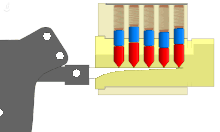Picking gun
A picking pistol , also known as an electric pick , is a mechanical or electrical unlocking tool for the semi-automatic, non-destructive opening of pin locks . It is a tool that is used, among other things, in the area of lock picking .
Procedure
The process of the picking pistol is similar to that of the bump key : both tools are based on the percussion method , and in many cases this allows relatively quick and non-destructive opening without a suitable key if pin locks are not appropriately secured . Bump wrenches must be available in the appropriate profile for use, the picking pistol allows the percussion method to be used independently of the key profile, but still requires a so-called spanner for turning the cylinder for use.
The picking gun basically consists of a metal mandrel, which is detachably mounted on the front of the picking gun and is available in various thicknesses and shapes. This metal mandrel is pushed into the lock as far as it will go, in a position in which the metal mandrel is just above or below the core pins , depending on the installation position of the cylinder , as shown in the graphic opposite. The core pins are shown in red to distinguish them, above the housing pins in blue. Above the housing pins, shown in brown, are the housing springs which hold the pins in a locked position without an inserted key.
Depending on the installation position and application, different picking pistols are available on the market: In the case of cylinder locks in doors used in Europe, the core pins are usually in the lower area, but downward-striking picking pistols are available. In North America, cylinder locks are usually installed in doors, as shown in the adjacent illustration, with the core pins going up. Picking pistols that hit upwards are to be used for this. Turning the picking pistol upside down in the position of use leads to inadequate results, especially with mechanical picking pistols. For padlocks or other applications, the selection of the striking direction depends on the respective situation.
The drive mechanism, either mechanically by hand or electrically with a small electric motor, pulls a spring mechanism in the picking gun up to a threshold and then suddenly relieves the spring, whereby a short, intense mechanical shock is transmitted via the metal mandrel to all core pins in parallel . With the percussion method, the impact of the core pins, which ideally hardly move, is transferred directly to the housing pins behind them, which are pressed into the housing for a brief moment against the spring force. If, during this short time, the lock cylinder is suitably rotated by means of an inserted tensioner, the tension on the tensioner must not be too great in order not to block the core pins and also not too small to prevent the housing pins from falling back into the locked state, the The cylinder can be turned further by means of a tensioner and the lock can be opened.
The process must be repeated for each full revolution of the cylinder. A pin lock can also be closed with the method in the opposite direction of rotation.
literature
- Ingo Wirth: Criminalistics Lexicon . CF Müller GmbH, 2011, ISBN 978-3-7832-0804-7 .

